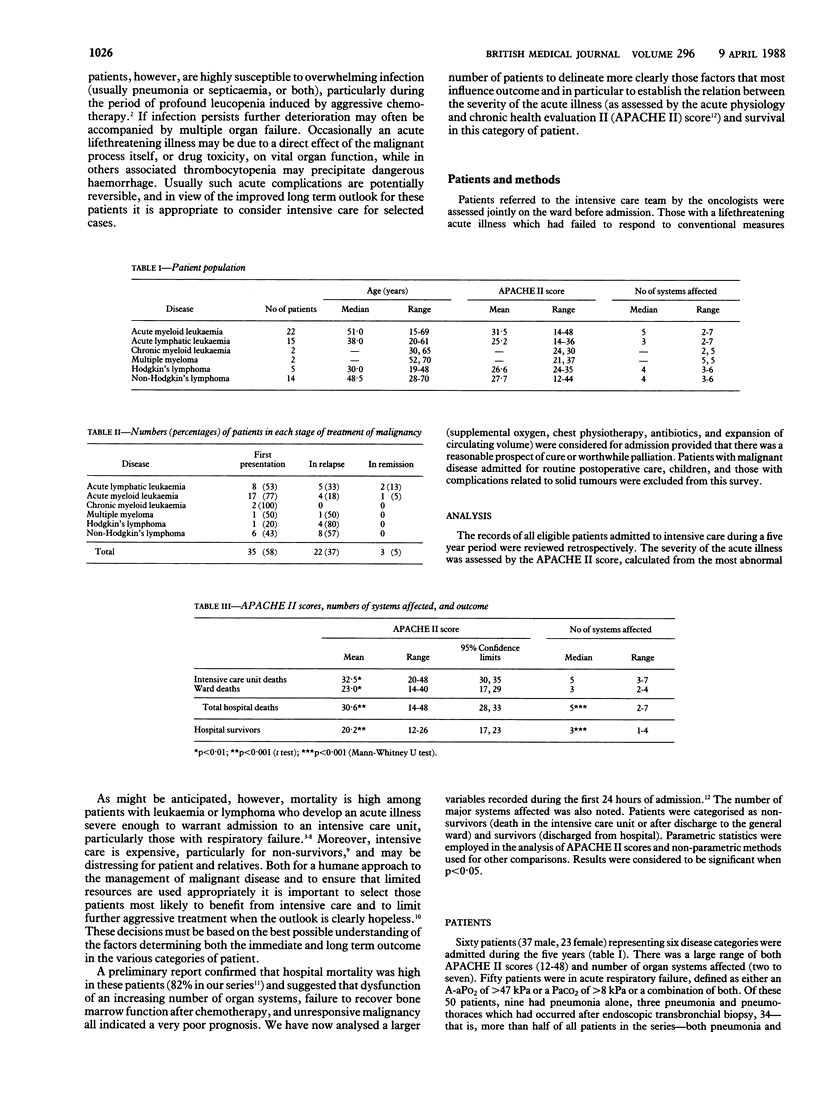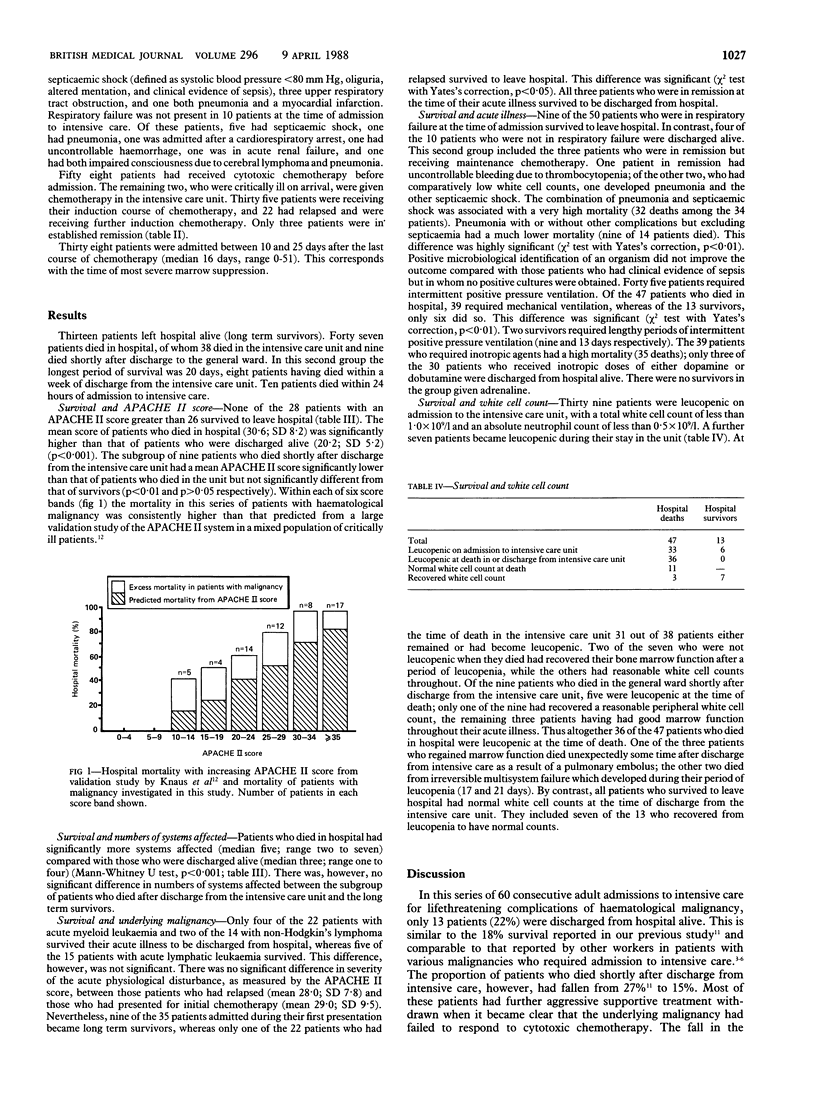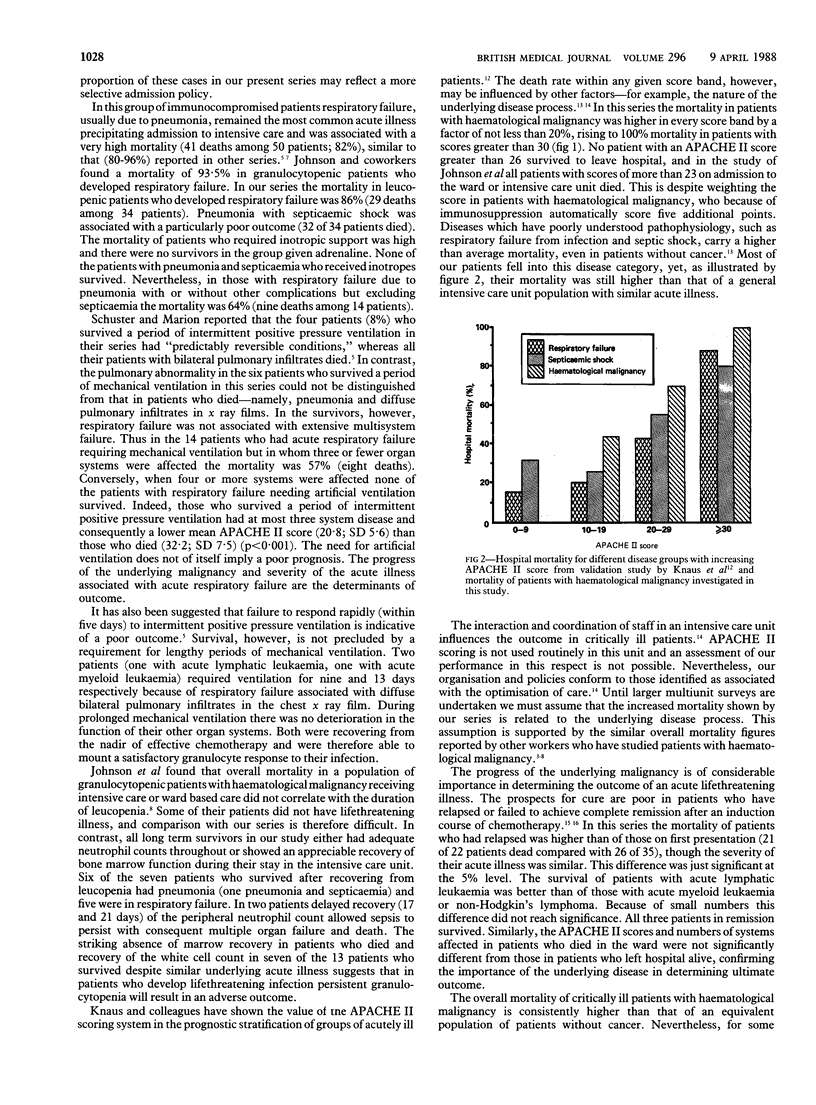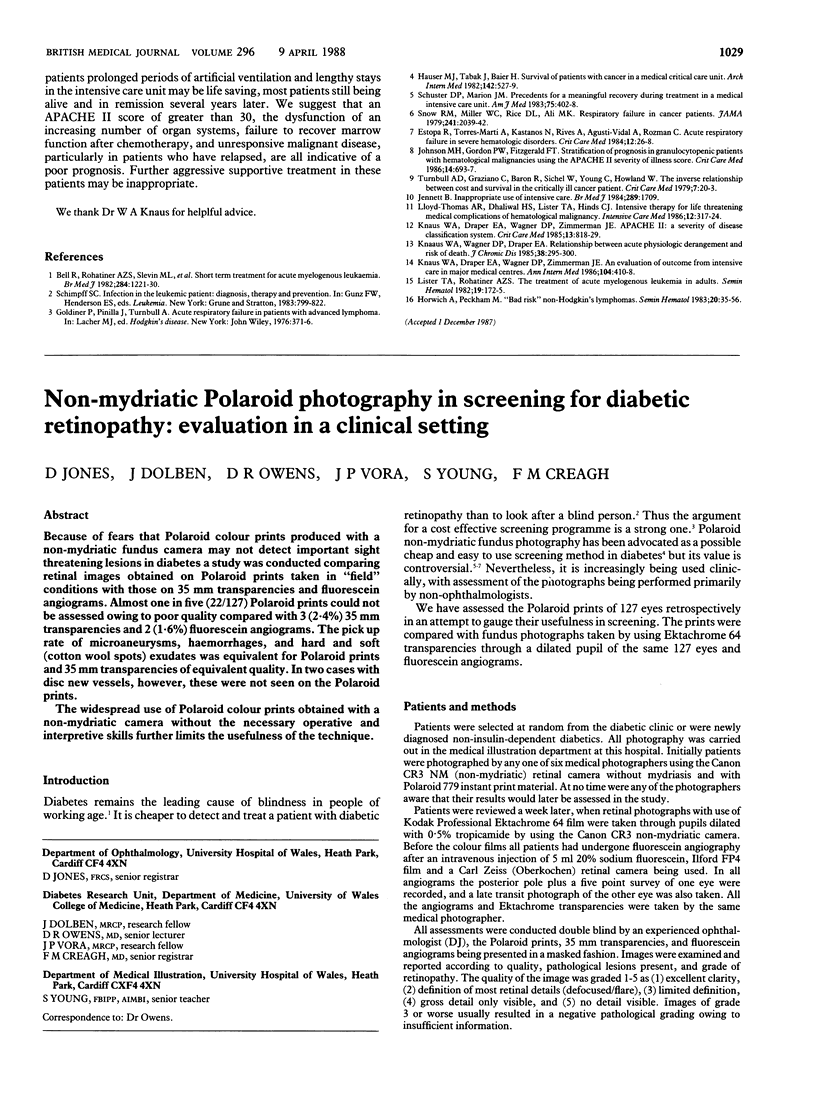Abstract
The mortality of patients admitted to intensive care units with haematological malignancy is high. A humane approach to the management of the critically ill as well as efficient use of limited resources requires careful selection of those patients who are most likely to benefit from intensive care. To delineate more accurately the factors influencing outcome in these patients the records of 60 consecutive admissions to the intensive care unit (37 male, 23 female) with haematological malignancy were reviewed retrospectively. Fifty patients were in acute respiratory failure, most commonly (34 patients) with a combination of pneumonia and septicaemic shock. The severity of the acute illness was assessed by the APACHE II (acute physiology and chronic health evaluation II) score and number of organ systems affected. Thirteen patients survived to leave hospital. The mortality of patients with haematological malignancy was consistently higher than predicted from a large validation study of APACHE II in a mixed population of critically ill patients. Moreover, no patient with an APACHE II score of greater than 26 survived. Mortality among the 22 patients with relapsed malignancy (21 deaths), was significantly higher than among the 35 patients at first presentation (26 deaths). On discharge from the intensive care unit all survivors had responded well to chemotherapy and had normal or raised peripheral white cell counts. They included seven patients who had recovered from leucopenia (white cell count <0.5 × 109/1). In contrast, 36 of the 47 patients who died were leucopenic at the time of death.
The overall mortality of critically ill patients with haematological malignancy is higher than equivalently ill patients without cancer. The dysfunction of an increasing number of organ systems, an APACHE II score of greater than 30, failure of the malignancy to respond to chemotherapy, and persistent leucopenia all point to a poor outcome.
Full text
PDF




Selected References
These references are in PubMed. This may not be the complete list of references from this article.
- Bell R., Rohatiner A. Z., Slevin M. L., Ford J. M., Dhaliwal H. S., Henry G., Birkhead B. G., Amess J. A., Malpas J. S., Lister T. A. Short-term treatment for acute myelogenous leukaemia. Br Med J (Clin Res Ed) 1982 Apr 24;284(6324):1221–1224. doi: 10.1136/bmj.284.6324.1221. [DOI] [PMC free article] [PubMed] [Google Scholar]
- Estopa R., Torres Marti A., Kastanos N., Rives A., Agusti-Vidal A., Rozman C. Acute respiratory failure in severe hematologic disorders. Crit Care Med. 1984 Jan;12(1):26–28. doi: 10.1097/00003246-198401000-00007. [DOI] [PubMed] [Google Scholar]
- Hauser M. J., Tabak J., Baier H. Survival of patients with cancer in a medical critical care unit. Arch Intern Med. 1982 Mar;142(3):527–529. [PubMed] [Google Scholar]
- Horwich A., Peckham M. "Bad risk" non-Hodgkin lymphomas. Semin Hematol. 1983 Jan;20(1):35–56. [PubMed] [Google Scholar]
- Johnson M. H., Gordon P. W., Fitzgerald F. T. Stratification of prognosis in granulocytopenic patients with hematologic malignancies using the APACHE-II severity of illness score. Crit Care Med. 1986 Aug;14(8):693–697. doi: 10.1097/00003246-198608000-00006. [DOI] [PubMed] [Google Scholar]
- Knaus W. A., Draper E. A., Wagner D. P., Zimmerman J. E. APACHE II: a severity of disease classification system. Crit Care Med. 1985 Oct;13(10):818–829. [PubMed] [Google Scholar]
- Knaus W. A., Draper E. A., Wagner D. P., Zimmerman J. E. An evaluation of outcome from intensive care in major medical centers. Ann Intern Med. 1986 Mar;104(3):410–418. doi: 10.7326/0003-4819-104-3-410. [DOI] [PubMed] [Google Scholar]
- Knaus W. A., Wagner D. P., Draper E. A. Relationship between acute physiologic derangement and risk of death. J Chronic Dis. 1985;38(4):295–300. doi: 10.1016/0021-9681(85)90075-x. [DOI] [PubMed] [Google Scholar]
- Lister T. A., Rohatiner A. Z. The treatment of acute myelogenous leukemia in adults. Semin Hematol. 1982 Jul;19(3):172–192. [PubMed] [Google Scholar]
- Lloyd-Thomas A. R., Dhaliwal H. S., Lister T. A., Hinds C. J. Intensive therapy for life-threatening medical complications of haematological malignancy. Intensive Care Med. 1986;12(4):317–324. doi: 10.1007/BF00261745. [DOI] [PubMed] [Google Scholar]
- Schuster D. P., Marion J. M. Precedents for meaningful recovery during treatment in a medical intensive care unit. Outcome in patients with hematologic malignancy. Am J Med. 1983 Sep;75(3):402–408. doi: 10.1016/0002-9343(83)90340-6. [DOI] [PubMed] [Google Scholar]
- Snow R. M., Miller W. C., Rice D. L., Ali M. K. Respiratory failure in cancer patients. JAMA. 1979 May 11;241(19):2039–2042. [PubMed] [Google Scholar]
- Turnbull A. D., Carlon G., Baron R., Sichel W., Young C., Howland W. The inverse relationship between cost and survival in the critically ill cancer patient. Crit Care Med. 1979 Jan;7(1):20–23. doi: 10.1097/00003246-197901000-00005. [DOI] [PubMed] [Google Scholar]


